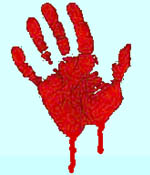
Censoring the Talmud | |||||||||||||||||||||||||||||||||||||||||||
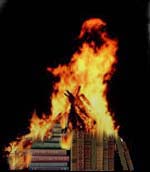 Censorship damages inter-religious and inter-cultural understanding — no matter who does it.
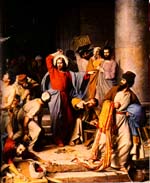
Jesus Cleansing the Temple 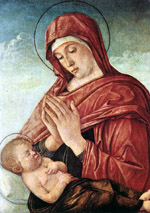
Mary, mother of Jesus. According to the Talmud: 
The Koran on Mary, mother of Jesus: 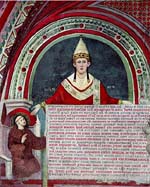 Pope Innocent III in a long decree stated: that Jews are "not to be killed by anyone [but], they are to us dangerous as the insect in the apple, as the serpent in the breast … Since, therefore, they have already begun to gnaw like the rat, and to stink like the serpent, it is to our shame that the fire in our breast which is being eaten by them, does not consume them … Although Christian piety tolerates the Jews … and allows them to continue with us, although the Moors will not tolerate them, they must not be allowed to remain ungrateful to us in such a way as to repay us with contumely, for favors, and contempt for our familiarity. They are admitted to our familiarity only through our mercy …" (9) 
Theodore Herzl, Hungarian lawyer of the 19th Century and founder of modern Zionism, apparently considered the great experiment — the attempt to create compatibility between Jews and people of other religions — a failure. 
Deborah Lipstadt is a professor of modern Jewish and Holocaust studies at Emory University. She also works with the U.S. Holocaust Memorial Museum. 
Hadrian, "Emperor of the Roman World Empire from 117 A.D. to his death, 138 A.D. In 132 A.D. the Jews began a revolt, and for four years carried on a bloody war." — Elizabeth Dilling (3) 
Pope John Paul II with the Chief Rabbi of Kiev.
 As the Catholic Church distances itself from Jesus' teachings, will this pope or a successor rule that the Gospels have been wrongly translated? That Jesus was misquoted? Or that Jesus mis-spoke, and has since retracted and apologized for his remarks? 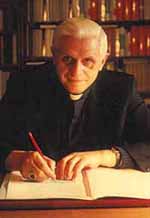
Joseph Cardinal Ratzinger, Prefect of the Congregation for the Doctrine of the Faith of he Roman Catholic Church and author of Many Religions-One Covenant: Israel, the Church, and the World. Cardinal Ratzinger writes: 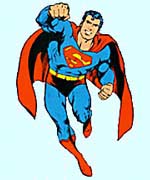
You can help in the battle for Truth, Justice, and the American Way! Fight the forces of censorship and suppression of the Talmud, and bring about understanding between peoples of different faiths. 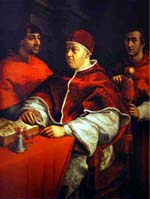 Pope Leo X was the son of Lorenzo the Magnificent of the House of Medici. He assumed the Throne of Peter in 1513. "There is only praise for the Medici Popes in Jewish literature and only disappointment about the condition of Jewry during the Reformation and afterwards, for the succeeding Popes drove the Talmudists out of Vatican circles and back into the ghetto." — Elizabeth Dilling (4)  Pope Julius III (fresco (8)) sat on the Throne of Peter from 1550 to 1555. This statue was commissioned in 1555 by the city of Perugia in gratitude to his Holiness for granting the city its independence, which had been taken away by the previous pope. (11) "Upon the denunciation of the baptized Jews Ananel di Foligno, Joseph Moro, and Vittorio Eliano, Julius issued (Aug. 12, 1553) an edict enjoining the bishops and magistrates to seize and burn all copies of the Talmud, as containing slanderous attacks against Christianity. With premeditated malice this edict was to be carried into effect on the day of the Jewish New-Year (Sept. 9, 1553). In the following year (May 29) Julius issued the bull "Contra Hebræos Retinentes Libros Thalmudis," in which the Jews were ordered, on pain of severe punishment, to give up within four months all books supposed to contain blasphemies against Jesus; such books to be revised by Christian censors, and the suspected passages expunged." — Jewish Encyclopedia (4)  Martin Luther spoke of the Jews in his last sermon: "You, Milords and men of authority, should not tolerate but expel them. They are our public enemies and incessantly blaspheme our Lord Jesus Christ; they call our blessed Virgin Mary a harlot and Her Son a bastard … if they could kill us all, they would gladly do so; in fact many of them murder Christians, especially those professing to be surgeons and doctors. They know how to deal with medicaments in the manner of the Italians — the Borgias and Medicis — who gave people poison which brought about their death in one hour or a month … As a good patriot I wanted to give you this warning for the very last time to deter you from participating in alien sins. You must know I only desire the best for you all, rulers and subjects." 
Rabbi Daniel Lapin, an Orthodox rabbi and author of America's Real War, states that Jews and Christians should work together and recognize their common values. America's real war, according to the dust jacket, is being fought between those who want a secular nation and those who want "a spiritual America." 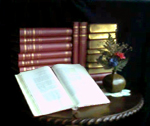
The Soncino Talmud was translated by world-renowned Talmud and Hebrew/Aramaic scholars. It was the first complete English translation ever published, and it has been the standard, commonly accepted rabbi-approved English translation for more than six decades. |
There is no doubt that Jesus of Nazareth and the Pharisees had a violent dislike for each other. This point has been a delicate one between Jews and Christians ever since. The tension, however, provides a good object lesson on the use of euphemisms and code words used in the Talmud to censor or obscure the meaning of the text. (Unless otherwise indicated, in the following excerpts we have omitted the Soncino footnotes. To study the footnotes and the full context, follow the link below the excerpt.) Let us look at this short excerpt from Tractate Sanhedrin. Speaking of a character called "Balaam," a Sage states: GEMARA. … He practised enchantment by means of his membrum. — Babylonian Talmud, Tractate Sanhedrin 105a What Is a Membrum?"Membrum" is not an English word. It is the Latin root of the English word "member." However, "membrum" is used in so many contexts by the Soncino translation team, perhaps we can puzzle out the meaning by examining the contexts: R. Jose, while boasting of his modesty to the other Sages, remarks: GEMARA. … R. Jose said: I have never looked at my circumcised membrum. — Babylonian Talmud, Tractate Shabbath 118b During a discussion of forbidden sexual relations, the Sages debate the exact point in the process that a brother dishonors his sister: GEMARA. … Now, this agrees with the view that the first stage [which dishonors her] is contact with her sexual organ; but on the view that the first stage is the insertion of the membrum, what can you say? — Babylonian Talmud, Tractate Sanhedrin 73b During a discussion of the death penalty for stubborn and rebellious adolescent boys, the Sages consider when boys are too young for execution. GEMARA. … R. Hiyya taught: Until he grows a beard round the corona. When R. Dimi came, he explained it thus: It means, until the hair surrounds the membrum, but not until it grows round the testicles. — Babylonian Talmud, Tractate Sanhedrin 68b Here, the Sages are discussing sex with a female slave, with a married woman in adultery, and a sotah, (a married woman under suspicion of adultery). (The ellipsis in this Gemara indicates non-germane text has been omitted. To see the full text, follow the link at the end of the excerpt.) GEMARA. … Raba said: For what purpose did the All Merciful write 'carnally' in connection with the designated bondmaid, a married woman, and a sotah? … That in connection with a married woman excludes intercourse with a relaxed membrum. This is a satisfactory interpretation in accordance with the view of him who maintains that if one cohabited with forbidden relatives with relaxed membrum he is exonerated. — Babylonian Talmud, Tractate Yebamoth 55b This is a special definition of cohabitation. (14) And later in the same folio: GEMARA. … R. Shesheth raised an objection: 'Carnally implies that guilt is incurred only when intercourse was accompanied by friction'; does this not refer to friction of the membrum! — No; friction of the corona. — Babylonian Talmud, Tractate Yebamoth 55b The Sages in this passage are discussing how a man should conduct his daily toilet in order to avoid touching his membrum. In the following, terumah means a Temple offering to be eaten by the priest. GEMARA. … If a priest, while eating terumah, felt a shiver run through his body he takes hold of his membrum and swallows the terumah. 'Takes hold'! But has it not been taught: R. Eliezer said, 'Whoever holds his membrum when he makes water is as though he had brought a flood on the world'? To this Abaye replied. 'With a thick rag'. Raba replied: It may even be said to apply to a soft rag for once the semen has been detached the subsequent touch does no longer matter. And Abaye? — He made provision against the possibility of an additional discharge. And Raba? — He does not consider the possibility of any additional discharges. But does he not, seeing that it was taught, 'To what may this be compared? To the putting of a finger upon the eye where, as long as the finger remains on it, the eye continues to tear'? Now Raba? — It is quite uncommon for one to get heated twice in immediate succession. — Babylonian Talmud, Tractate Niddah 13a Later in the text: GEMARA. … Rab Judah and Samuel once stood upon the roof of the Synagogue of Shaf-weyathib in Nehardea. Said Rab Judah to Samuel 'I must make water'. 'Shinena', the other replied, 'take hold of your membrum and make the water outside [the roof]'. But how could he do so, seeing that it was taught: R. Eliezer said, Whoever holds his membrum when he makes water is as though he brought a flood on the world? — Babylonian Talmud, Tractate Niddah 13a At this point it is probable that we have a sufficient number of contexts to discern the meaning of "membrum." Let's move on. Who Is Balaam?Now, who was Balaam who "practised enchantment by means of his membrum"? Originally, the Old Testament Balaam was a prophet from the heathen tribes who was hired to curse the Israelites on their journey from Egypt (Numbers 22-24). Balaam refused that commission, blessing the Israelites instead. Later, he earned the wrath of the Israelites and was slain by them (Numbers 31:8). Mention of Balaam occurs thereafter in the Books of Deuteronomy, Joshua, Nehemiah, and Micah, sometimes as a wicked man, sometimes as good. In the opinion of many modern rabbinical scholars, "Balaam" was often used by the Sages as an alias or code word for Jesus of Nazareth. For example, consider this statement about Balaam from the prestigious Jewish Encyclopedia: Henceforth he became the type of false prophets seducing men to lewdness and obscene idolatrous practices (Rev. ii. 14; II Peter ii. 15; Jude 11; Abot. v. 19). The name 'Nicolaitanes,' given to the Christian heretics 'holding the doctrine of Balaam' (Rev. ii. 6, 15), is probably derived from the Grecized form of Balaam, [Hebr. char.] = [Greek char.], and hence also the pseudonym given to Jesus in Sanh. 106b and Git. 57a. — The Jewish Encyclopedia (1) (emphasis added) The Jewish Encyclopedia's article on Jesus contains much information about various pseudonyms used for Jesus in the Talmud, including "Balaam," "son of Pandera," and "Ben Stada." Why would the Sages use a code word for Jesus of Nazareth? Perhaps to avoid confrontations with the Christian establishment. By disguising unflattering remarks about Jesus, only those inside the circle of Talmud believers would understand; Christians, if they ever saw the material, would miss the significance. An example is given by Rabbi Rodkinson in his book, The History of the Talmud. In 1239 A.D., Jewish apostates brought charges in Rome that the Talmud contained sacrilegious sayings about Jesus and His mother. Rabbi Jechial answered the charges (in part) by denying that the Talmud contained any mention of Jesus of Nazareth: To the other accusations of Donin, that the Talmud terms the followers of Jesus Christ "Minim" (infidels), that it condemns Jesus, that it allows ill-usage of people of other nationalities, etc., he [Rabbi Jechial] replied: "In the Talmud there is no mention of Jesus (Jesu) Christ, but only of another Jesus (Jeshua) who was a disciple of R. Joshua b. Prachia, who lived two hundred years before Christ." — Rabbi Rodkinson (2) Balaam's Mother a Harlot, Sanh. 106a, 106bIn Tractate Sanhedrin 106a and 106b, the Sages discuss Balaam and his mother. We get another clue about Balaam's identity with the hint that Balaam's mother "played the harlot with carpenters." GEMARA. … Balaam also the son of Beor, the soothsayer, [did the children of Israel slay with the sword]. A soothsayer? But he was a prophet! — R. Johanan said: At first he was a prophet, but subsequently a soothsayer. R. Papa observed: This is what men say, 'She who was the descendant of princes and governors, played the harlot with carpenters.' (5) [106b] Did the children of Israel slay with the sword among them that were slain by them. Rab said: They subjected him to four deaths, stoning, burning, decapitation and strangulation. — Babylonian Talmud, Tractate Sanhedrin 106a - 106b In a footnote, Rabbi Dr. H. Freedman promotes scholar Rev. Dr. Herford's view that the "harlot" is a reference to Mary, mother of Jesus.
— Rabbi Dr. Freedman It is of course, impossible for any man to undergo "four deaths" as told in Sanhedrin 106b, above. This detail does not aid in the identification. It may, however, express the fate that the Sages thought "Balaam" deserved. (Rabbi Michael Rodkinson omits that passage in Sanhedrin 106a without footnote or comment. See Do Not Censor the Talmud, Please "Appendix B: Rabbi Rodkinson's Censored Talmud," for discussion and cites.) "Balaam Being Used As an Alias for Jesus"Sanhedrin 106b continues. A Sage is asked a question about Balaam by a min. According to the Soncino Talmud Glossary, min is the Talmud word for Christian. That a min is asking after the details of Balaam's life is a further clue to the identity of that character. In the Soncino Talmud, this paragraph follows immediately on the paragraph quoted above. GEMARA. … A certain min said to R. Hanina: Hast thou heard how old Balaam was? — He replied: It is not actually stated, but since it is written, Bloody and deceitful men shall not live out half their days, [it follows that] he was thirty-three or thirty-four years old. He rejoined: Thou hast said correctly; I personally have seen Balaam's Chronicle, in which it is stated, 'Balaam the lame was thirty years old when Phinehas the Robber killed him.' (11) — Babylonian Talmud, Tractate Sanhedrin 106b Rabbi Dr. H. Freedman, translator, does not explain why a Christian would ask the Pharisee about Jesus, but he interprets this passage as follows:
— Rabbi Dr. Freedman The interpretation that "Balaam" is Jesus is persistent, but the denial is also persistent. In February 2003, the Anti-Defamation League of B'nai B'rith issued a position paper entitled The Talmud in Anti-Semitic Polemics. (17) Naming the Soncino as a preferred translation (on page 13), the ADL states (on page 12): Jesus and Balaam — Anti-Defamation League (17) (emphasis added) Let us consider the following points. The ADL states:
Given that the ADL uses patently untrue premises in its argument, how reliable is the ADL's conclusion — that Balaam is not Jesus? That the ADL accepts the Soncino Talmud, but selectively rejects the Soncino scholarship on the Balaam references is significant. It indicates that, to the ADL and the public they are addressing, those passages are politically sensitive. It is apparently important to the ADL to assert that the Talmud is not hostile to Christianity, so important that ordinary rules of scholarship may be bent in the assertion. This, too, is a form of censorship. Given the legal clout of the ADL and the readiness with which it blackens reputations with the "anti-Semitic" label, scholars in these matters are not free to draw conclusions according to the rules of scholarship. Instead, with the constant threat that statements considered unfavorable to the Talmud will result in punishment of the scholar, scholars are driven by political concerns to draw the "correct" conclusions and censor their own work. See further discussion of the freedom of scholarship in Appendix: Deborah Lipstadt Finds Anti-Semitism in the New Testament Balaam's Membrum, Sanh. 105a, 105bIn the last Soncino footnote we cited, Rabbi Dr. Freedman quotes Rev. Dr. Herford that Balaam is "frequently used in the Talmud as a type for Jesus." This agrees with the view of the writers and editors of The Jewish Encyclopedia: "Balaam" is used in multiple places in the Talmud as pseudonym for Jesus. In the next passage, Balaam limped on one foot, was blind in one eye, practiced enchantment by means of his membrum, and committed bestiality with his ass. Elizabeth Dilling understood this passage to be about Jesus, and certainly we could not fault her or anyone else who interprets it in that way. (24) GEMARA. … R. Johanan said: Balaam limped on one foot, as it is written, And he walked haltingly. Samson was lame in both feet, as it is written, [Dan shall be a serpent by the way,] an adder in the path that biteth the horse's heels. Balaam was blind in one eye, as it is said, [and the man] whose eye is open … He practised enchantment by means of his membrum. For here it is written, falling, but having his eyes open; whilst elsewhere is written, And Haman was fallen on the bed whereon Esther was. — Babylonian Talmud, Tractate Sanhedrin 105a - 105b Jesus Was a MagicianAccording to The Jewish Encyclopedia, Jesus was often accused by the Talmudists of performing magic. It is the tendency of all these sources to belittle the person of Jesus by ascribing to him illegitimate birth, magic, and a shameful death … — The Jewish Encyclopedia (26) So Elizabeth Dilling is on firm ground believing that the passage stating that Balaam "performed magic by means of his membrum" refers to Jesus of Nazareth. Healing Hurt FeelingsToo many have glossed over the problems between Jews and Christians, but America is fortunate to have a rabbi who is willing to broach the subject. That rabbi is Schmuley Boteach, a popularizer of Judaism and the author of more than a dozen books, including Judaism for Everyone. In a section of that book, entitled "Jewish Contempt for Other Nations," Rabbi Boteach first mentions the abuse that Jews have suffered at the hands of Christians. He continues: Second, the Jews felt that, in Christianity, their core teachings had been perverted and abused. They read some of the New Testament's insidious attacks against them and wondered how a book claiming divine authorship can be so blatantly anti-Semitic. Although Christianity stemmed from Jewish origin, it took the concept of the Jewish God and associated it with a man; took the concept of sacrifice and associated it with a human sacrifice. Christianity took their cherished Torah and said that it had been superseded by a new testament. And finally, it took the concept of the chosen nation itself, claimed that the Jews had been abandoned by God, and called themselves the new Israel. Jews reacted in outrage. The Jews withdrew from mainstream Christian society. Christians' burning Jews at the stake as heretics would do little to make them draw closer. — Rabbi Boteach (15) Two pages later, Rabbi Boteach writes of the healing process: Although Christianity was the enemy of Jews and Judaism for nearly two millennia, times have changed. The Vatican, under the current pope, a true friend of the Jewish people, has granted diplomatic recognition to the State of Israel, and Christian fundamentalists in the United States are among the State of Israel's most trusted backers. — Rabbi Boteach (16) Notice that when Rabbi Boteach refers to "the New Testament's insidious attacks," he does not mention the name of the person who launched the insidious attacks. That person who launched the attack against the Pharisaic Jews (Rabbi Boteach's religious ancestors) was of course, Jesus of Nazareth. Going the Extra MileIf Rabbi Boteach is too uncomfortable to mention His name, we question whether the wounds have been healed. For its part, the Roman Catholic Church seems to be willing to go the distance. The Jewish Week in a report on the 2002 Vatican document, "The Jewish People and the Holy Scriptures and the Christian Bible," states: The new document also reportedly contains an apology to the Jewish people for anti-Semitic passages contained in the New Testament, and also stresses the continuing importance of the Torah for Christians. — The Jewish Week (21) What will the Vatican do next? Will Cardinal Ratzinger declare that the Gospels were mistranslated, that Jesus was misquoted, or that Jesus mis-spoke, and has since issued a retraction and apology? Consider how accommodating the Vatican has been on another issue: the virginity of Mary, mother of Jesus. It seems that scholars studying the Dead Sea Scrolls have decided that the Gospels were mistranslated: the word that was translated as "virgin" was really the Hebrew word for "young woman." On that basis, the Vatican will revise its doctrines. 25 November 2001— Publication of the Dead Sea Scrolls — 15,000 papyrus documents discovered in the desert that have changed scholars' views on the Bible — is finally being completed, after more than half a century of bitter squabbling, censorship and academic controversy. — The Independent (22) If Jesus was not born to a virgin, Jesus' birth was not exceptional, and Jesus was not God made flesh. Thus the Vatican is planning to change a keystone doctrine of Christianity on the basis of a Hebrew word written by Essene scribes, members of a Jewish sect. According to the Jewish faith, Jesus' birth was natural. Moreover, the Essenes could not have any direct knowledge of Mary's situation. Even given that the Vatican is willing to concede Christianity for a single word, how will it explain verses such as the following?
— Luke 1:31, 34-35 (KJV) Whether one is an atheist, an agnostic, a Muslim, a Hindu, or a Christian, the truth of Rabbi Boteach's statement is obvious: The Vatican, under the current pope [is] a true friend to the Jewish people. — Rabbi Boteach (16) Let the Truth Be KnownTo echo the sentiments of Rabbi Sacks, we need patience to find out about each others' faiths. In the meantime, we urge Rabbi Boteach and his co-religionists to come forward and openly discuss the Talmud's charges against Jesus. For example, the charge that Jesus of Nazareth practiced enchantment by means of His membrum is not treated in the Gospels of Matthew, Mark, Luke, or John: Therein, you will not find any mention of the Pharisees making such a charge at the time of the trial. Perhaps, in the history of Jews and Christians, it would have served better if Jewish leadership had told Christians what they believed to be the truth. Christians may have made adjustments in their doctrines accordingly. Even in the current climate of enlightenment, Jews seem reluctant to step forward with the information. This author recently conducted a search of the International Council of Christians and Jews website,(13) and a number of other Jewish-Christian cooperative sites, but found no mention of the word "membrum." Now is the time for Jews to step forward with the issue. Let us advance Rabbi Sacks' goal of finding out about each other's faiths. More on Balaam and JesusSoncino Press included an index of each tractate as it was published. In 1952, Soncino published a separate volume containing a collated index of the previously published 63 tractates. (5)
— Meet Ben StadaElizabeth Dilling discusses other references to Jesus in the Talmud under the alias "Ben Stada." See Jewish Religion: Its Influence Today, Chapter III, in the section entitled "The Talmud — Five Deaths to Jesus." (6) Tractate Sanhedrin 67a (footnote 5, page 456) contains this interesting footnote by the translator, Rabbi Dr. H. Freedman: In the uncensored editions of the Talmud there follows this important passage (supplied from D.S. on the authority of the Munich and Oxford Mss. and the older editions) 'And this they did to Ben Stada in Lydda ([H]), and they hung him on the eve of Passover. Ben Stada was Ben Padira. R. Hisda said: 'The husband was Stada, the paramour Pandira. But was nor the husband Pappos b. Judah? — His mother's name was Stada. But his mother was Miriam, a dresser of woman's hair? ([H] megaddela neshayia): — As they say in Pumbaditha, This woman has turned away ([H]) from her husband, (i.e., committed adultery).' T. Herford, in 'Christianity in the Talmud', pp. 37 seqq, 344 seqq, identifies this Ben Stada with Jesus of Nazareth. As to the meaning of the name, he connects it with [G] 'seditious', and suggests (p. 345 n. 1) that it originally denoted 'that Egyptian' (Acts XXI 38, Josephus, Ant. XX, 8, 6) who claimed to be a prophet and led his followers to the Mount of Olives, where he was routed by the Procurator Felix, and that in later times he might have been confused with Jeshua ha-Notzri. This hypothesis, however, involves the disregard of the Talmudic data, for Pappos b. Judah lived a century after Jesus (Git. 90a), though the mother's name, Miriam (Mary), would raise no difficulty, as [H] megaddela neshayia may be the result of a confusion with Mary Magdalene (v. also Box, The Virgin Birth of Jesus, pp. 201f, for other possible meanings of Ben Stada and Ben Pandira) Derenbourg (Essai note 9, pp. 465-471) rightly denies the identity of Ben Stada with Jesus, and regards him simply as a false prophet executed during the second century at Lydda. — Rabbi Dr. Freedman (12) Apparently then, though the translator and editor believe this passage is a part of the original Tractate Sanhedrin, they have put it into a footnote rather than the main text. Ben Stada occurs again in Tractate Shabbath 104b. First the mention, which is a discussion of an earlier Mishnah (quoted in uppercase): HE WHO SCRATCHES A MARK ON HIS FLESH, [etc.] It was taught. R. Eliezer said to the Sages: But did not Ben Stada bring forth witchcraft from Egypt by means of scratches (1) [in the form of charms] upon his flesh? (2) He was a fool, answered they, and proof cannot be adduced from fools. — Babylonian Talmud, Tractate Shabbath 104b Soncino translator, Rabbi Dr. H. Freedman, expands in the footnotes:
— Rabbi Dr. Freedman Footnote 2 refers back to the Sanhedrin passage, above. Again, apparently, the Soncino preserves the earlier censorious action by removing the passage from the main text. But in the midst of a confusing and obscure debate, the accusation that the subject is Jesus — is muted. Yet, the passages that permit the sacrifice of children to Moloch (see Human Sacrifice, the Talmud, and the Moloch Problem), that permit sex with girls as young as three (see Sex with Children by Talmud Rules), that provide guidelines for murdering neighbors without liability (see The Jewish Religion: Its Influence Today, Chapter 5), that permit fathers to sell their daughters into slavery (see Talmud Daughters Become Talmud Wives) — and even the thinly disguised passages wherein Jesus was called Balaam (as described in this article) — those passages are left intact by the "censors." This suggests that the censors were not Christian, but Talmudists themselves, tailoring the Talmud to a presumed level of acceptability. The Soncino editor and translator do not state who they consider censored the Ben Stada passages, or why, and the question remains open. For further discussion of Jesus in the Talmud, see "Christ" in the Index of "The Jewish Religion: Its Influence Today."
Thank you for your consideration of the above,
NEXT: Death Penalty 1: Sentence and Execution
Endnotes:
Appendix: Deborah Lipstadt Finds Anti-Semitism in the New TestamentOn April 8, 1998 on PBS's The NewsHour with Jim Lehrer, a group of prominent persons discussed the Papal apology for what the Pope calls the Catholic Church's silence during the Holocaust. One of the speakers, Deborah Lipstadt, a professor of modern Jewish and Holocaust studies at Emory University, broadened the scope of her remarks from the Vatican to comments on the New Testament generally. And there are other places — this tends to set this, I think, false dichotomy, speaking as an historian, between anti-Judaism and anti-Semitism and to suggests [sic] that Nazi anti-Semitism was something that grew up ex-Nihilo, out of nothing. In truth, that without the anti-Judaism — much of it anti-Semitism — of the New Testament, or at least in the way the New Testament has been interpreted and taught, there would have been no Nazism, and there would have been no Holocaust. I'm not saying that it was inevitable, but it is a direct outgrowth. — Deborah Lipstadt (25) Deborah Lipstadt, who is not a Christian, is free to discuss passages in the New Testament that she considers "anti-Judaism." Five years later, the ADL still features Professor Lipstadt on their website, indicating that ADL does not consider Professor Lipstadt engaged in hate speech. Nor has ADL demanded that Professor Lipstadt, Jim Lehrer, or PBS apologize for Lipstadt's remarks on PBS. However, ADL recently condemned Gentiles who find anti-Gentile quotes in the Talmud. ADL says these Gentiles are using the quotes "to foment anti-Semitism." (17) According to Deborah Lipstadt, criticism of the Jews (found in the Gospels) reveals anti-Semitism. But according to the ADL, noticing that Gentiles are criticized in the Talmud also reveals anti-Semitism. If a Jew can speak about anti-Jewish text in Christian Scripture, shouldn't a Gentile be allowed to speak about anti-Gentile text in Jewish Scripture? Americans are used to free give and take. When the ADL closes down open discussion, it creates anti-Semitism. How can that bring about understanding between people of different faiths? | ||||||||||||||||||||||||||||||||||||||||||
Footnotes:
Full specifics for each of the printed sources are provided in the Bibliography. Outside URLs were valid at the time this article was written. However, be mindful that URLs do change.
- The Jewish Encyclopedia, Vol. II, p. 469, available at http://www.come-and-hear.com/je/je_469.html#E275. The Encyclopedia cites Sanhedrin 106b and Gittin 57a.
- The History of the Talmud, Vol. I, page 66-68, et seq.: http://www.come-and-hear.com/talmud/rodkinson_4.html#p66.
- The Jewish Religion: Its Influence Today, Chapter II, page 6 available at http://www.come-and-hear.com/dilling/chapt02.html#page_6
- Jewish Encyclopedia, s.v. "Julius III. (Giovanni Maria Del Monte)," Vol. VII, page 391-392 available at http://www.jewishencyclopedia.com/view.jsp?artid=721&letter=J
- For an attestation to the usefulness of the Soncino Talmud General Index, see the Very Rev. the Chief Rabbi Dr. Israel Brodie's Foreword
- The Jewish Religion: Its Influence Today, Chapter III, page 15 available at http://www.come-and-hear.com/dilling/chapt03.html#page_15
- The History of the Talmud, Vol. I, page 10 available at http://www.come-and-hear.com/talmud/rodkinson_1.html#p10
- Pope Julius III, Fresco in the Church of the Sacro Speco, Subiaco (Contemporary)
- The Jewish Religion: Its Influence Today, Chapter II, page 7 available at http://www.come-and-hear.com/dilling/chapt02.html#page_7
- Toward Tradition: http://www.towardtradition.org
- Pope Julius III by Vincenzo Danti in Perugia, Italy, 1555
- Sanhedrin 67a, page 456, footnote 5 appears as footnote 12 in Come and Hear™ hypertext, available at http://www.come-and-hear.com/sanhedrin/sanhedrin_67.html#67a_12
- International Council of Christians and Jews, http://www.iccj.org/
- By context, here and elsewhere, it is evident that the Soncino translators have adopted "cohabitation" as a euphemism for sexual intercourse. In normal English, cohabitation means only "living together" or "living together in an assumed sexual relationship outside marriage".
- Judaism for Everyone, page 295
- Ibid, page 297
- "The Talmud in Anti-Semitic Polemics," Anti-Defamation League, http://www.adl.org/presrele/asus%5F12/the_talmud.pdf cached at http://www.come-and-hear.com/supplement/adl-talmud.pdf
- Ibid, page 13
- Ibid, page 9
- The Jewish Religion: Its Influence Today, page 1, available at http://www.come-and-hear.com/dilling/chapt01.html#page_1
- The Jewish Week, 01/25/2002, http://www.thejewishweek.com/news/newscontent.php3?artid=5649 cached at http://www.come-and-hear.com/editor/so-jw-01-25-02
- "Publishing's new sensation: Dead Sea Scrolls," The Independent, 25 November 2001, http://news.independent.co.uk/world/middle_east/story.jsp?story=106705 (available at original source only through membership) cached at http://www.come-and-hear.com/editor/marynotavirgin
For authenticated archive, see http://web.archive.org/web/20011125162146/http://news.independent.co.uk/world/middle_east/story.jsp?story=106705 - Theodore Herzl in The Jewish State, paraphrased by Louis Lipsky for The Universal Jewish Encyclopedia, s.v. "Herzl," Vol. 5, page 338
- The Jewish Religion: Its Influence Today, Chapter III, page 15 available at http://www.come-and-hear.com/dilling/chapt03.html#page_15
- "Papal Apology," The NewsHour with Jim Lehrer, PBS, Transcript, April 8, 1998, http://www.pbs.org/newshour/bb/religion/jan-june98/vatican_4-8.html cached at http://www.come-and-hear.com/editor/pbs-june98
- The Jewish Encyclopedia, s.v. "Jesus," Vol. VII, pages 171 and 172. Facsimile pages available as The Jewish Religion: Its Influence Today, Exhibit 277, Exhibit 278, and Exhibit 279, also available at http://www.jewishencyclopedia.com/view.jsp?artid=254&letter=J&search=jesus#1017
- We were unable to locate a yeshiva or theological seminary in or called "Kfar Hassidim," or mention thereof in any publication on the Internet. We were, however, able to find Kfar Chabad, the Chabad-Lubavitcher village in the Lod Valley that contains a school for boys. (http://www.chabadnews.us/gallery/Page_0006/0006.htm) Perhaps a curious reader will have better luck.
- America's Real War, page 11
- Chabad-Lubavitch Library of Brooklyn N. Y.: "volume no: 4053, location: 2-L, Lev Eliyahu, A Collection of Talks, by: Lopian, Eliyahu, Jerusalem ,1975, 8. xli, 330 p." http://www.chabadlibrary.org/ecatalog/EC04/EC04053.HTM
- "Great Leaders of our People - Rabbi Eliyahu Lapian (1876-1976)," Union of Orthodox Jewish Congregations of America, http://www.ou.org/about/judaism/rabbis/lapian.htm cached at http://www.come-and-hear.com/editor/na-rabbi-lapian
- Many Religions, One Covenant: Israel, the Church, and the World, by Joseph Cardinal Ratzinger, page 21
© Copyright Carol A. Valentine, 2003. See copyright statement at http://www.come-and-hear.com/copyright.html
NEXT: Death Penalty 1: Sentence and Execution
| Navigate This Site | |
 | |
| Home | |
| Valentine | |
| Dilling | |
| Talmud | |
| The Rabbis | |
| Supplement | |
| Glossary | |
| Download | |
| Admin | |
| | |
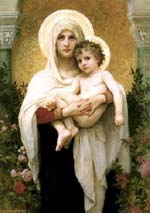

 Genuine Come and Hear™ CDs do not contain executable programs. When making CDs, do not include any files that end in .exe, .com, .bat, .vbs, .doc, .pif, .sit, or .scr. The person receiving the CD should use his own browser to view the files. This helps to protect him from harmful programs and viruses.
Genuine Come and Hear™ CDs do not contain executable programs. When making CDs, do not include any files that end in .exe, .com, .bat, .vbs, .doc, .pif, .sit, or .scr. The person receiving the CD should use his own browser to view the files. This helps to protect him from harmful programs and viruses. 



